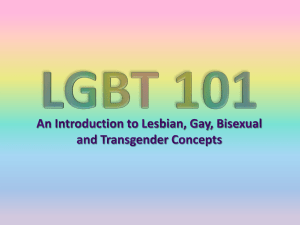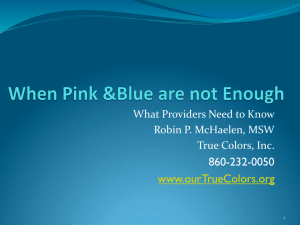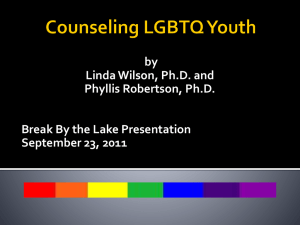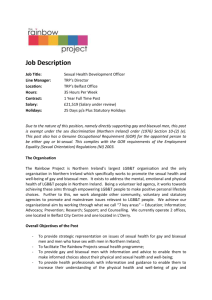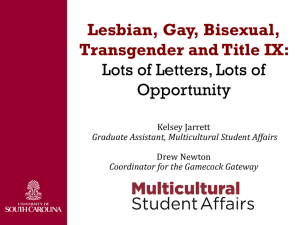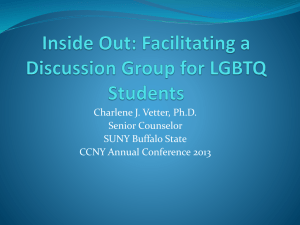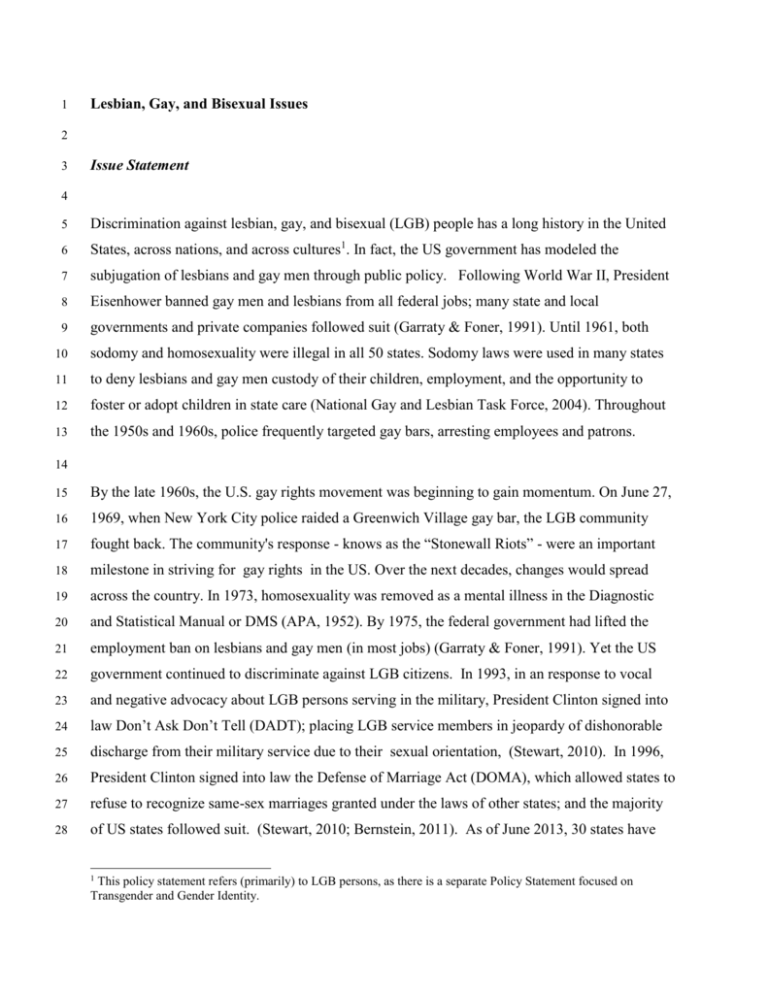
1
Lesbian, Gay, and Bisexual Issues
2
3
Issue Statement
4
5
Discrimination against lesbian, gay, and bisexual (LGB) people has a long history in the United
6
States, across nations, and across cultures1. In fact, the US government has modeled the
7
subjugation of lesbians and gay men through public policy. Following World War II, President
8
Eisenhower banned gay men and lesbians from all federal jobs; many state and local
9
governments and private companies followed suit (Garraty & Foner, 1991). Until 1961, both
10
sodomy and homosexuality were illegal in all 50 states. Sodomy laws were used in many states
11
to deny lesbians and gay men custody of their children, employment, and the opportunity to
12
foster or adopt children in state care (National Gay and Lesbian Task Force, 2004). Throughout
13
the 1950s and 1960s, police frequently targeted gay bars, arresting employees and patrons.
14
15
By the late 1960s, the U.S. gay rights movement was beginning to gain momentum. On June 27,
16
1969, when New York City police raided a Greenwich Village gay bar, the LGB community
17
fought back. The community's response - knows as the “Stonewall Riots” - were an important
18
milestone in striving for gay rights in the US. Over the next decades, changes would spread
19
across the country. In 1973, homosexuality was removed as a mental illness in the Diagnostic
20
and Statistical Manual or DMS (APA, 1952). By 1975, the federal government had lifted the
21
employment ban on lesbians and gay men (in most jobs) (Garraty & Foner, 1991). Yet the US
22
government continued to discriminate against LGB citizens. In 1993, in an response to vocal
23
and negative advocacy about LGB persons serving in the military, President Clinton signed into
24
law Don’t Ask Don’t Tell (DADT); placing LGB service members in jeopardy of dishonorable
25
discharge from their military service due to their sexual orientation, (Stewart, 2010). In 1996,
26
President Clinton signed into law the Defense of Marriage Act (DOMA), which allowed states to
27
refuse to recognize same-sex marriages granted under the laws of other states; and the majority
28
of US states followed suit. (Stewart, 2010; Bernstein, 2011). As of June 2013, 30 states have
1
This policy statement refers (primarily) to LGB persons, as there is a separate Policy Statement focused on
Transgender and Gender Identity.
29
their own constitutional DOMA provisions and seven others have statutory DOMA provisions.
30
(National Conference of State Legislatures, 2013; Killian, 2010).
31
32
The 2000’s have brought a range of legislative and policy changes that had a direct impact on
33
LGB persons. In 2001, the creation of the White House Office of Faith-Based and Community
34
Initiatives found the Bush Administration having to publicly address the concerns that funding
35
recipients were provided exemptions to local and state anti-discrimination laws. This led to
36
concerns that faith-based groups were denying equal access to services based on sexual
37
orientation and gender identity. The Supreme Court ruling on June 26, 2003 (in Lawrence v.
38
State of Texas) invalidated Texas sodomy laws, and by extension, invalidated sodomy laws in
39
thirteen other states. The ruling made same-sex sexual activity legal in every U.S. state and
40
territory. Later in 2003, the Massachusetts Supreme Court ruled that banning lesbians and gay
41
men from marrying was a violation of the state’s constitution, opening the way for same-sex
42
couples to legally marry in the state. The 2010’s has seen the momentum continue. In
43
December of 2010, after years of public pressure, including from those in the military, the
44
Obama administration signed the repeal of the “Don’t Ask, Don’t Tell” law (Advocate, 2012a).
45
In 2011, the Obama Administration declared that they would no longer defend the federal
46
DOMA in cases that were pending in the state and federal courts (HRW, 2011). In March of
47
2013, the US Supreme court agreed to hear two cases that focus on marriage equality:
48
California’s Proposition 8 (Hollingsworth v. Perry) which did not recognize same-sex marriage
49
in California; and a broader case (based on DOMA) that addressed the denial of federal benefits
50
and programs to same-sex couples (United States v. Windsor) (NASW, 2013). In June of 2013,
51
the Supreme Court of the United States struck down the Defense of Marriage Act (DOMA) as
52
unconstitutional, and ruled that the State of California must resume issuing marriage licenses to
53
same-sex couples in that state. As of July 2013, there are 13 US States and Washington, D.C.
54
that allow same-sex marriage; additionally, four (4) states allow civil unions, and 3 states allow
55
some level of spousal rights to domestic partners (NCSL, 2013). While most of these states’ laws
56
have been made by legislative or court action, popular vote has made same-sex marriage legal in
57
3 states, and is an important milestone in the fight for LGB rights (HRW, 2012; HRC, 2013).
58
59
Marriage equality increases access to the over 1,000 federal protections and responsibilities
60
historically denied to gay, lesbian, bisexual and transgender families under DOMA. Yet it must
61
be noted that same-sex couples cannot legally marry in most states and territories of the United
62
States, creating uncertainty about the extent to which same-sex spouses will receive federal
63
(marital-based) protections nationwide as is currently afforded opposite-sex spouses. The
64
implementation of the marriage equity for same-sex couples has created a domino effect in
65
related federal policy. For example, in June 2013, the Social Security Administration (SSA)
66
published new rules that make it easier for the estimated 700,000 transgender Americans to
67
update their Social Security records to reflect their gender designation.
68
69
Despite changes in state and national legislation and public policy, heterosexism and
70
discrimination persist. Lesbian, gay, bisexual (and transgender) people do not have the full civil
71
and statutory protection under the law as defined in Title VII of the Civil Rights Act. (Herek &
72
Berrill, 1992). The lesbian, gay, bisexual (and transgender) population continues to face
73
discrimination related to many state and federal laws along with some religious exemptions
74
within a number of laws and potential laws such as the Employment Non-Discrimination Act
75
(ACLU, 2013).
76
77
Internationally, other countries were also beginning to fight against discrimination of LGB
78
people. In 1994, the United Nations ruled that discrimination based on sexual orientation violates
79
the International Covenant on Civil and Political Rights. In 1996, post-apartheid South Africa
80
became the first country to include nondiscrimination based on sexual orientation in its
81
constitution. From 1981 to 2003, the European Court of Human Rights overturned sodomy,
82
recognized gay and lesbian partnerships, condemned discriminatory age-of-consent laws (that is,
83
differing age of consent to engage in sex for heterosexual versus LGB youths), and gave trans-
84
gender people the right to legally change their identity and to marry (Human Rights Watch,
85
2004). In 1998, Denmark legalized same-sex partnerships; within two years, Norway, Sweden,
86
Iceland, and France followed.
87
88
In 2001, the Netherlands legalized same-sex marriages, followed in 2003 by Belgium. Other
89
countries have followed suit, predominately in Europe but two South American countries,
90
Argentina and Paraguay, and one African country, South Africa, currently allow same-sex
91
marriages with France and New Zealand being the most recent countries to legalize same-sex
92
marriages. According to Gay Marriage ProCon (2013), currently there are 14 of 194 countries
93
which allow same-sex marriage though there are other countries in which various states and
94
provinces allow same-sex marriage. Yet violence, oppression, and persecution of sexual
95
minorities throughout much of the international community continue (HRW, 2013). The United
96
Nations continues to lead the way in advocating for the rights of the LGB population
97
internationally. In 2012, the United Nations Human Rights/Office of the High Commissioner
98
released, “Born Free and Equal: Sexual orientation and gender identity in Human Rights Law”.
99
The document outlines five core legal obligations of UN member states in protecting the human
100
rights of LGBT persons: 1) Prohibition discrimination based on sexual orientation and gender
101
identity, 2) legal protections from homophobic and trans phobic violence, 3) prevention of
102
torture and degrading treatment, 4) decriminalization of same-sex relationships, and 5) respect
103
for and freedom of expression, association and assembly. In July 2013, the United Nations
104
initiated a Global Public Education Campaign called “Free and Equal” based on the publication/
105
(UNHR, 2013)
106
107
Though strides are being made in political arenas in the U.S. and across the world, denial of
108
rights and discriminatory practices remain in many institutions. There have been positive and
109
affirming changes within many religious organizations, but many continue to discriminate
110
against sexual minorities through policies which exclude the LGB population from full inclusion
111
in community based organizations and spiritual life. Practices such as “Sexual Orientation
112
Change/Conversion Efforts” (SOCE) and Reparative Therapy, while discredited by all
113
professional mental health organizations, continue to be a form of therapeutic intervention used
114
by a small but vocal group of practitioners. Emerging in practice in the early 1990s, researchers
115
and mental health practitioners have noted that the therapy is most often unsuccessful and in
116
many cases harmful. In 2012 the preeminent SOCE supporter and researcher, Robert Spitzer,
117
noted flaws in his research, and formally retracted of his 2001 study that claimed gays could
118
switch their sexual orientation. (Hein & Matthews, 2010; Advocate, 2012b) Despite the lack of
119
scientific evidence as support, there are a number of advocates who claim success in their efforts
120
at sexual orientation change.
121
122
123
Population Affected
124
It is estimated that 3.4 percent of U.S. adults, or approximately 8 million in 2010, identify as
125
lesbians, gay men or bisexuals ((U.S. Census, 2011; Gates, & Newport, 2012). However, this
126
estimated number of sexual minorities may not reflect the valid, total population. Sexual
127
orientation continues to be stigmatized in U.S., resulting in those with same-sex attraction and/or
128
behavior not identifying as part of the LGB community due to the societal stigma of minority
129
sexual orientation and fear of ostracization (Gates, & Newport, 2012). Consequently, the exact
130
number of LGB adults in the U.S. is unknown. The lesbian, gay and bisexual community in the
131
U.S. is significant and, despite a shared minority sexual orientation, is heterogeneous.
132
133
Sexual minorities are a diverse group of people often characterized by their same-sex attraction,
134
sexual behavior, and/or identity as lesbians, gay men, bisexuals, and transgender. This
135
population’s diversity is recognized across many demographic characteristics, including gender,
136
age, income, and race/ethnicity. Sexual minorities are affected by social issues, including
137
poverty, violence, health disparities and oppression that impact their wellbeing just as are other
138
minority populations. In a study of poverty among lesbians, gay men and bisexuals, researcher
139
found that lesbians and bisexual women were more likely to be poor than heterosexual women,
140
while men have similar economic status regardless of sexual orientation (Albelda, Badgett,
141
Schneebaum & Gates, 2009). Violence, such as hate crimes, suicide and bullying, are other
142
social issues that adversely impact lesbians, gay and bisexuals adults and youth. Hate crimes
143
based on sexual orientation has increased over time. In 2003, the FBI reported 16 percent of all
144
hate crimes were due to sexual orientation bias; in 2011, that number is at almost 21 percent.
145
(FBI, 2012). Research suggests that harassment of LGB people is related to higher rates of
146
depression, suicide, high school dropout, and teen homelessness (CDC, 2013).
147
148
Research has repeatedly shown that sexual minority youth report higher rates of sexual, verbal
149
and physical assault than heterosexual youth. LGB youth, who experience violence at school,
150
are more likely to have more absences than their heterosexual peers and experience adverse
151
educational and health outcomes that persist into adulthood (CAP, 2010). These health
152
disparities are exemplified in psychiatric and medical conditions in youth and adults, with the
153
overall stressors experienced by LGB youth resulting in a greater risk for mental health
154
problems, substance use, and physical health problems (CDC, 2013).
155
156
LGB youth and adults appear to be disproportionately diagnosed with depression and substance
157
abuse than heterosexual youth and adults, respectively (Institute of Medicine, 2011). LGB
158
persons also appear to be disproportionately affected by certain types of cancer, such as lung,
159
breast and cervical, as compared to heterosexuals (Brown & Tracy, 2008). The prejudice and
160
discrimination experienced by sexual minorities may be further compounded by the impact of
161
discrimination due to other (multiple) Identities (e.g., race, ethnicity, age, gender). For example,
162
older LGB adults are at an increased risk to experience depression, social isolation and elder
163
abuse due to prejudice and discrimination based on their sexual minority status (National Gay
164
and Lesbian Task Force, 2010).
165
166
Lesbian, gay, and bisexual persons are also members of families. Yet unequal access to family
167
planning (e.g., adoption, foster parenting, reproductive health services) due to policies and laws,
168
not only diminish these relationships, but result in fewer resources and increased poverty level
169
for many LGB(T) families. For example LGB parents cannot adopt jointly in the majority of the
170
United States (Family Equity Council (FEC), 2011) More than 30 years of rigorous social
171
science research shows that children raised by LGBT parents are just as happy and their peers in
172
non-LGB families.
173
174
Sexual orientation stigma, prejudice, discrimination and other elements that support a
175
heterosexist system of oppression in the United States are the leading explanatory factors for the
176
social issues that affect the LGB population (Institute of Medicine, 2011).
177
178
Despite the successes of the equal rights movement, there continues to be discrimination against
179
LGB(T) people. Thirty-five states do not equally protect all persons from discrimination in
180
employment, education, credit, housing, and other public accommodations. Voters in United
181
States continue to pass state – level constitutional amendments that prohibit same-sex marriage,
182
and multiple states do not allow lesbians or gay men to adopt, or foster children. State laws
183
continue to prohibit any discussion of homosexuality in school or “mandate that any references
184
to homosexuality be exclusively negative”.
185
The federal government has also failed to support nondiscrimination against LGB(T) people.
186
The 1994 Employment Non-Discrimination Act (ENDA), which would protect LGB(T) people
187
from workplace discrimination, has failed to pass Congress. The LGB community represent all
188
of the diversity of our society— people of color, people with disabilities, older adults,
189
immigrants, refugees, and people of all religious and political beliefs. The complexities of mul-
190
tiple forms of oppression cannot be ignored. The collective impact of discrimination,
191
homophobia, and heterosexism has had a serious impact on LGB people. Homophobia and het-
192
erosexism has created ineffective and inappropriate service delivery for sexual minority people.
193
Reflected in laws and policies that devalue individuals and families, homophobia and/or
194
heterosexism work to reduce the effectiveness of services and programming for all clients.
195
Taken to the extreme, a practitioner’s ignorance and/or disregard for LGB persons can lead to the
196
use of Sexual Orientation Change/Conversion Efforts (SOCE) and/or Reparative Therapy;
197
practices explicitly condemned by NASW, the American Psychological Association, the
198
American Counseling Association, and the American Psychiatric Association (Just the Facts
199
Coalition, 2008; NASW, 2000).
200
201
Understanding the history of the LGB communities, the impact of discrimination, stigma, and
202
laws and policies on individuals, families, and communities, are critical component to ensuring
203
culturally competent social work practice. As noted in the NASW code of ethics, “the primary
204
mission of the social work profession is to enhance human wellbeing and help meet the basic
205
human needs of all people, with particular attention to the needs and empowerment of people
206
who are vulnerable, oppressed, and living in poverty.” Social workers are expected to
207
“challenge social injustice” and “respect the inherent dignity and worth of the person (NASW,
208
2008).
209
210
It is the position of the NASW that same-gender sexual orientation should be afforded the same
211
respect and rights as other-gender orientation. Discrimination and prejudice directed against any
212
group is damaging to the social, emotional, and economic well-being of the affected group and
213
of society as a whole.
214
215
POLICY STATEMENT
216
NASW is committed to advancing policies and practices that will improve the status and well-
217
being of all lesbian, gay, and bisexual people. NASW reaffirms its support of the Transgender
218
and Gender Identity Issues policy statement, recognizing the intersection of oppression among
219
lesbian, gay, bisexual, transgender, and intersex people. NASW has a separate policy statement
220
on transgender and gender identity issues, and therefore, this policy primarily addresses lesbian,
221
gay, and bisexual people (LGB).
222
223
It must be noted Lesbian, Gay, Bisexual, and Transgender persons can share a similar history,
224
identify with similar communities and cultural identities; and may have multiple identities based
225
on sexual orientation and gender identify. Therefore, the impact of stigma, discrimination, and
226
inequality outlined in this policy statement, and the proposed policy statements, are equally
227
relevant to LGBT persons and their families. It is essential that NASW take a strong stance on
228
behalf of all LGBT people and work to end the prejudice, oppression, and discrimination
229
experienced on a daily basis.
230
231
NASW as an organization, the social work profession, approaches practice from a strengths
232
based and holistic perspective. NASW and social workers worldwide must continue to work
233
with faith based organizations, community based organizations (including faith based
234
organizations), public and private sector agencies, businesses and governments to end
235
discrimination and exclusion of sexual minorities across the spectrum of daily living.
236
237
238
Nondiscrimination and Equality
239
NASW supports all social agencies, universities, professional associations, and funding
240
organizations in their efforts to broaden statements of nondiscrimination to include sexual
241
orientation and gender identity.
242
243
NASW supports the adoption of local, state, federal, and international policies/legislation
244
that ban all forms of discrimination based on sexual orientation and gender identity. LGB
245
people must be granted all rights, privileges, and responsibilities that are granted to
246
heterosexual people, including but not limited to inheritance rights, insurance, marriage,
247
child custody and visitation, employment, credit, housing and immigration.
248
249
NASW supports the adoption of local, state, federal, and international policies/legislation
that protect the rights and well-being of the children of lesbian, gay, and bisexual people.
250
251
252
NASW supports efforts to end discrimination and harassment of lesbian, gay, and bisexual
253
youths in public schools. NASW also supports the rights of LGB youths and allies to
254
organize and operate in schools.
255
256
NASW will promote LGBT human rights and support advocates and civil society groups
in the US and globally through programmatic and financial assistance.
257
258
259
260
Professional and Continuing Education
NASW encourages curriculum policies in schools of social work that eliminate discrimi-
261
nation against lesbian, gay, and bisexual people. Schools of social work are expected to
262
articulate the NASW position in curriculum policy and standards; to require content on
263
lesbian, gay, and bisexual people throughout the curriculum, in field instruction, and in
264
continuing education programs and through the selection of textbooks; and to provide
265
training for classroom instructors, field supervisors, and field advisers regarding lesbian,
266
gay, and bisexual issues.
267
268
NASW encourages social workers to increase their awareness of oppression, heterosexism, homophobia, and the intersection of multiple forms of oppression.
269
270
NASW encourages licensing bodies to include questions specific to lesbian, gay, and
bisexual sex issues.
271
272
273
NASW supports school-based programming that addresses and stops anti-gay bullying,
violence, and other forms of discrimination.
274
275
276
NASW strives for full representation and establishment of means to affirm the presence
277
of lesbian, gay, and bisexual people at all levels of leadership and employment in social
278
work and in NASW and its chapters.
279
280
NASW does not condone nor support the use of SOCE or so-called Reparative Therapies
281
by any person identifying as a social worker or any agency that identifies as providing
282
social work services. Public dollars should not be utilized for programs that support
283
SOCE.
284
285
NASW supports the expansion of the Employment Non-Discrimination Act (ENDA) to
286
include perceived or actual gender identity or sexual orientation to provide equal
287
protections for LGBT people from discrimination in employment, education, credit,
288
housing, and other public accommodation
289
290
Education and Public Awareness
291
292
NASW encourages the development of programs, training, and information regarding the
293
specific health, mental health, and development needs of lesbian, gay, and bisexual
294
youths and their families.
295
296
297
298
NASW encourages the development of programs to increase public awareness of the
violence and social injustice experienced by lesbian, gay, and bisexual people.
299
NASW encourages the development of programs, training, and information that promote
300
proactive efforts to end the violence and stereotypes perpetrated against lesbian, gay, and
301
bisexual people.
302
303
NASW applauds and supports organizations that fund, develop, and provide
304
programming that portrays the lesbian, gay, and bisexual communities compassionately
305
and accurately.
306
307
308
Health and Mental Health Services
NASW supports the right of the individual to self-disclose, or to not disclose, sexual
309
orientation and encourages the development of supportive practice environments for
310
lesbian, gay, and bisexual clients and colleagues.
311
NASW reaffirms its stance against reparative therapies and treatments designed to
312
change sexual orientation or to refer clients to practitioners or programs that claim to do
313
so (NASW, 2000).
314
NASW strongly advocates for the availability of culturally appropriate comprehensive
315
health and mental health services for LGB people across the life span, including HIV
316
prevention and treatment; substance abuse treatment; psychological stress and
317
dysfunction prevention and treatment; and suicide prevention.
318
NASW calls for expanded resources to help federally funded community health centers
319
(CHCs) provide improved care for LGBT clients, including culturally competent training
320
for health and mental health providers;
321
NASW recognizes the increasing number of lesbian, gay, and bisexual people who are
322
making reproductive choices and encourages the establishment of legal, medical, and
323
psychological supports for these families.
324
Federal agencies must work to combat criminalization of LGBT status, including
325
protecting vulnerable LGBT refugees and asylum seekers both in the United States and
326
globally.
327
Political Action and Advocacy
328
NASW encourages all social workers to develop and participate in coalition with other human
329
rights, social action, and professional associations to lobby for the rights of lesbian, gay, bisexual
330
and transgender people; and to defeat efforts to limit the rights of LGBT persons.
331
and antigay violence.
332
333
NASW advocates for increased funding for programs designed to eliminate hate crimes
NASW advocates for expanded federal law that legalizes and recognizes marriage of
334
same-sex couples and provide pathways to immigration and citizenship to bi-national
335
same-sex families that are equal to opposite – sex couples.
336
health and mental health services.
337
338
NASW supports the legal recognition of LGBT Families through comprehensive parental
recognition laws at the state level to fully protect children in LGBT families.
339
340
NASW advocates for increased funding for programs designed to provide education,
NASW calls upon the United States and our global social work allies to fund and
341
implement changes necessary to meet the core obligations of state with respect to
342
protecting the human rights of LGBT persons.
343
344
Research
345
346
issues affecting lesbian, gay, bisexual, and transgender people.
347
348
NASW advocates for increased funding for research that increases our understanding of
NASW supports expanded funding for research to build a more solid evidence base for
349
LGBT health concerns will not only benefit LGBT individuals, but also add to the
350
repository of health information we have that pertains to all people.
351
Ensure culturally appropriate comprehensive health and mental health services for LGB
352
people across the life span, including HIV prevention and treatment; substance abuse
353
treatment; psychological stress prevention and treatment; and suicide prevention.
354
355
REFERENCES
356
Advocate. (2012a). 45 Years of History. Advocate, [online] http://www.advocate.com/arts-
357
entertainment/advocate-45/2012/08/21/45-years-stirring-pot
358
Advocate. (2012b). Researcher Robert Spitzer Retraction. [online]
359
http://www.advocate.com/health/2012/05/30/researcher-robert-spitzer-puts-his-apology-gay-
360
people-video
361
Albelda, R., Lee Badgett, M. V., Schneebaum, A., & Gates, G. J. (2009). Poverty in the lesbian,
362
gay, and bisexual community. Retrieved from The Williams Institute website:
363
http://williamsinstitute.law.ucla.edu/research/census-lgbt-demographics-studies/poverty-in-
364
the-lesbian-gay-and-bisexual-community/
365
366
367
368
369
American Civil Liberties Union. (2013, May 15). Momentum Continues to Build for Narrowing
ENDA's Religious Exemption. Retrieved from ACLU Web site: http://aclu.org
American Psychiatric Association. (1952). Diagnostic and statistical manual: Mental disorders.
Washington, DC: Author.
Bernstein, M. (2011). United States: Multi-Institutional Politics, Social Movements and the
370
State. In D. P. Carol Johnson, The Lesbian and Gay Movement and the State: Comparative
371
Insights into a Transformed Relationship (pp. 197-211). Burlington, VT: Ashgate Publishing
372
373
374
Brown, J. P., & Tracy, J. K. (2008). Lesbians and cancer: An overlooked health disparity.
Cancer Causes and Control, 19(10), 1009 – 1020.
Center for American Progress (CAP). 2010. Gay and Transgender Youth Homelessness by the
375
Numbers [online] http://www.americanprogress.org/issues/lgbt/news/2010/06/21/7980/gay-
376
and-transgender-youth-homelessness-by-the-numbers/
377
378
379
Centers for Disease Control and Prevention (CDC). 2013. Lesbian, Gay, Bisexual, and
Transgender Health. [online] at: http://www.cdc.gov/lgbthealth/youth.htm
Family Equity Council. (2011). All Children Matter: How Legal and Social Equalities Hurt
380
LGBT Families.
381
http://action.familyequality.org/site/PageServer?pagename=AllChildren
382
[online]
Federal Bureau of Investigation (FBI) Hate Crime Accounting 2011. (2012) [ online ]
383
http://www.fbi.gov/news/stories/2012/december/annual-hate-crimes-report-released/annual-
384
hate-crimes-report-released
385
386
Garraty, J., & Foner, E. (Eds.). (1991). A reader’s companion to American history. New York:
Houghton Mifflin.
387
Gates, G. J., & Newport, F. (2012). Special report: 3.4% of U.S. adults identify as LGBT.
388
Retrieved from GALLUP website: http://www.gallup.com/poll/158066/special-report-adults-
389
identify-lgbt.asp x
390
391
392
393
394
395
396
397
398
Hein, L. C., & Matthews, A. K. (2010). Reparative Therapies: The Adolescent, the Psych Nurse,
and the Issues. Journal of Child and Adolescent Psychiatric Nursing, 23, 29-35.
Herek, G. M., & Berrill, K. T. (1992). Hate crimes: Confronting violence against lesbians and
gay men. Newbury Park, CA: Sage Publications.
Human Rights Campaign. (2013, May 14). Respect for Marriage Act. Retrieved from The
Human Rights Campaign: http://www.hrc.org
Human Rights Watch. (2012, 11 7). US: State Votes a Global Victory for Gay Rights. Retrieved
from Human Rights Watch: http://www.hrw.org
Human Rights Watch. (2011, 2 24). US: Congress Should Repeal Defense of Marriage Act.
399
Retrieved from Human Rights Watch: http://www.hrw.org/news/2011/02/24/us-congress-
400
should-repeal-defense-marriage-act
401
Human Rights Watch. (2004). Lesbian and gay rights: Resource library for international
402
jurisprudence on sexual orientation and gender identity. Retrieved March 25, 2005, from
403
http://hrw.org/lgbt/jurisprudence.htm
404
Institute of Medicine (IOM) (2011). The health of lesbian, gay, bisexual, and transgender people:
405
Building a foundation for better understanding. Washington, D. C.: The National Academies
406
Press.
407
Just the Facts Coalition. (2008). Just the facts about sexual orientation and youth: A primer
408
for principals, educators, and school personnel. Washington, DC: American Psychological
409
Association. Retrieved from
410
www.apa.org/pi/lgbc/publications/justthefacts.html.http://www.apa.org/pi/lgbc/facts.pdf
411
412
Killian, M. L. (2010). The Political is Personal: Relationship Recognition Policies in the United
413
States and Their Impact on Services for LGBT People. Journal of Gay & Lesbian Social
414
Services, 9-21.
415
Lawrence v. State of Texas, 123 Supreme Court. 2472 (2003).
416
National Association of Social Workers. (2000). Position statement: “Reparative” and “con -
417
version” therapies for lesbians and gay men. [online] http:// www
418
.naswdc.org/diversity/lgb/reparative.asp
419
NASW (2008). Code of Ethics. [online at http://www.socialworkers.org/pubs/code/default.asp
420
NASW (2013). Amicus Brief (Hollingsworth v Perry; United States v. Windsor). [Online]
421
422
http://www.socialworkers.org/ldf/brief_bank/
National Gay and Lesbian Task Force. (2010). Outing age 2010: Public policy issues affecting
423
lesbian, gay, bisexual and transgender elders. Retrieved from National Gay and Lesbian Task
424
Force website: http://www.thetaskforce.org/reports_and_research/outing_age_2010
425
National Gay and Lesbian Task Force. (2004). Sodomy. Retrieved March 24, 2005, from
426
427
428
429
430
431
432
http://www.thetaskforce.org/theissues/is sue.cfm?issueID=11
National Conference of State Legislatures. (2013, May 15). Defining Marriage: Defense of
Marriage Acts and Same-Sex Marriage Laws. Retrieved from NCSL Web site: http://ncsl.org
ProCon.org. (2013, June 13). Gay Marriage ProCon.org. Retrieved from
http://gaymarriage.procon.org/
Stewart, C. (2010). United States. In C. Stewart, The Greenwood Encyclopedia of LGBT Issues
Worldwide (pp. 263-288). Santa Barbara: Greenwood Press.
433
U. S. Department of Commerce, Economics and Statistics Administration, U. S. Census Bureau.
434
(2011). Population distribution and change: 2000 to 2010 (U. S. Department of Commerce
435
Publication No. C2010BR – 01). Retrieved from http://www.census.gov/2010census/
436
437
438
439
440
441
United Nations Human Rights (UNHR), (2012). Free and Equal [online]
http://www.ohchr.org/Documents/Publications/BornFreeAndEqualLowRes.pdf
United Nations (1948). The universal declaration of human rights. [online]
http://www.un.org/en/documents/udhr/index.shtml



